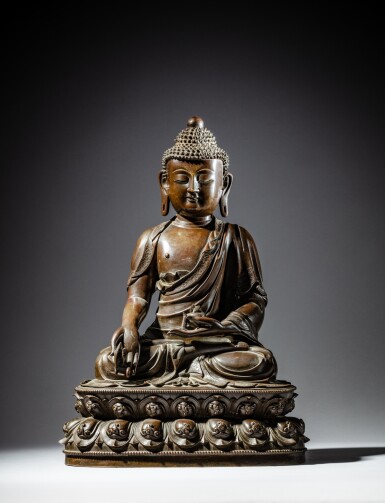Arts d'Asie
Arts d'Asie

A large bronze figure of Bhaishajyaguru Buddha, Ming dynasty, 15th - 16th century | 明十五至十六世紀 銅藥師佛坐像
Auction Closed
June 15, 03:38 PM GMT
Estimate
15,000 - 25,000 EUR
Lot Details
Description
A large bronze figure of Bhaishajyaguru Buddha
Ming dynasty, 15th - 16th century
the finely cast and incised bronze depicting the Medicine Buddha holding a myrobalan in his right hand, a patra containing myrobalan fruit in the right, and seated in vajraparyankasana on a double lotus pedestal
Height 40.1 cm, 15¾ in.
__________________________________________________________________________
Statue de Bouddha Bhaishajyaguru en bronze, dynastie Ming, XVe - XVIe siècle
__________________________________________________________________________
明十五至十六世紀 銅藥師佛坐像
The Medicine Buddha is worshipped according to the ancient Indian text of the bhaishajyaguru sutra, traditionally believed to have been taught by Shakyamuni Buddha. The popularity of the Medicine Buddha in Chinese worship is evident in the large ca. 1319 Bhaishajyaguru mural from Lower Guangshengsi, Shanxi Province, see James C. Y. Watt, The World of Khubilai Khan: Chinese Art in the Yuan Dynasty, New York, 2010, p. 89, fig. 118; the large and important inscribed gilt bronze Bhaishajyaguru dated first year of Jingtai (1450) in the Capital Museum, see Han Yong, Gems of Beijing Cultural Relics Series: Buddhist Statues I, Beijing, 2001, pp. 153-54, pls. 115-17: and in the number of Qing period fifty-one deity three-dimensional Bhaishajyaguru mandalas, such as the almost-complete set of bronzes in the State Hermitage, St. Petersburg, see Marylin M. Rhie & Robert A. F. Thurman, Wisdom and Compassion: The Sacred Art of Tibet, London, 1991, cat. no. 134.
The classic early Ming style of the loosely draped cloth of the Buddha’s robe falling in elegant, pleated folds on the lotus base, and the flourish on the tips of the petals of the double lotus pedestal suggest a late fifteenth date century for this finely cast and engraved bronze of the Medicine Buddha.
